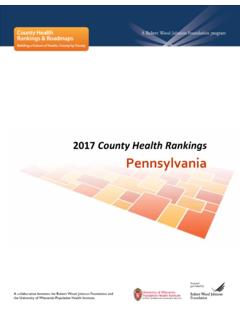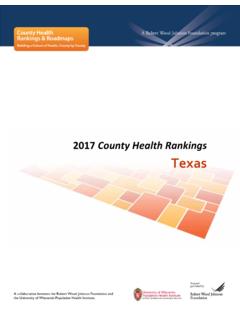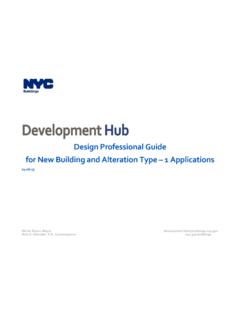Transcription of DEVELOPING EFFECTIVE COALITIONS
1 DEVELOPING EFFECTIVE COALITIONS :An Eight step Guide265 29th StreetOakland, CA EFFECTIVE COALITIONS :An Eight step GuideLarry Cohen, MSWN ancy Baer, MSWPam Satterwhite, MAPrevention Institute is a nonprofit, national center dedicated to improving communityhealth and well-being by building momentum for EFFECTIVE primary prevention. Prima-ry prevention means taking action to build resilience and to prevent problems beforethey occur. The Institute's work is characterized by a strong commitment to communityparticipation and promotion of equitable health outcomes among all social and eco-nomic groups.
2 Since its founding in 1997, the organization has focused on injury andviolence prevention, traffic safety, health disparities, nutrition and physical activity, andyouth paper and related tools and materials are available at our 29th StreetOakland, CA EFFECTIVE COALITIONS : An Eight step GuideAlthough the examples given in this paper are specific to injury preventioncoalitions, most can be applied to COALITIONS working on a variety of health-related issues. Written in the format of eight specific steps, this paper attemptsto give structure to a process that is somewhat variable.
3 Therefore, this paper isto be used as a general guide . Each group will find ways of interpreting theeight steps to best suit its own needs. The particular details of the solutionsarrived at by each coalition will be unique. DEVELOPING EFFECTIVE COALITIONS : An Eight step guide was originally devel-oped at the Contra Costa County (California) Health Services Department Pre-vention Program to assist public health programs in DEVELOPING EFFECTIVE com-munity COALITIONS for injury prevention. The ideas presented in this paper arean outgrowth of a Special Project of Regional and National Significance(SPRANS) grant awarded to the Contra Costa County Health Services Depart-ment by the Department of Health and Human Services Maternal andChild Health Division.
4 It was edited and printed by the Children s Safety Net-work at the National Center for Education in Maternal and Child Health. Anearlier version of the paper was also published in the Injury Awareness andPrevention Centre News, Vol. 4, No. 10, Alberta, Canada, December version of this paper was published in Mary Ellen Wurzbach s CommunityHealth Education and Promotion: A guide to Program Design and Evaluation(2nd ed. Gaithersburg, Md: Aspen Publishers; 2002:144-161).CCiittaattiioonn iinnffoorrmmaattiioonn:: Cohen L, Baer N, Satterwhite P. DEVELOPING EFFECTIVE COALITIONS : an eight stepguide.
5 In: Wurzbach ME, ed. Community Health Education & Promotion: AGuide to Program Design and ed. Gaithersburg, Md: AspenPublishers Inc; 2002 Nancy Baer can be reached at further information or permission to reprint or distribute this paper, pleasecontact Prevention 29th StreetOakland, CA professionals attend numerous meetings and sometimes assume thatthey understand everything it takes for working groups to succeed. Often,however, groups fail or, perhaps worse, avoid this type of expe-rience, which only erodes faith in collaborative efforts, people need tosharpen the skills that are necessary to build and maintain COALITIONS .
6 Thispaper contributes to the discussion of group processes by offering an eightstep guide to building EFFECTIVE COALITIONS . This paper is written from theperspective of an organization considering initiating and leading a coalitionbut can be helpful to anyone eager to strengthen a coalition in which heor she IS A coalition ?A coalition is a union of people and organizations working to influenceoutcomes on a specific problem. COALITIONS are useful for accomplishing abroad range of goals that reach beyond the capacity of any individual mem-ber goals range from information sharing to coordina-tion of services, from community education to advocacy for major envi-ronmental or policy (regulatory) changes.
7 In this Eight step guide , the wordcoalitionis used in a generic sense to represent a broad variety of organi-zational forms that might be approach outlined in this paperis intended to be used by any collaborative group seeking to influence out-comes or goals, or by anyone participating in an ongoing set of coalition can be an EFFECTIVE means of achieving a coordinated approachto injury prevention. For example, many agencies that focused primarily onproviding direct services after the occurrence of violent incidents wantedto join together to develop EFFECTIVE ways to prevent violence.
8 As a result,government and agency leaders established the Violence Prevention Coalition1 PPrreevveennttiioonn IInnssttiittuutteeDEVELOPING EFFECTIVE COALITIONS : An Eight step Guide11 DEVELOPING EFFECTIVE COALITIONS :An Eight step guide The opportunity to interactwith people from relatedprograms strengthens myday-to-day work. Now I know who to refer myclients to and where to gofor advice when I need it. Without the coordinationthat this coalition provides,we never would haveaccomplished such a broad policy objective. Another meeting? I d like to attend but I have real work to do.
9 This coalition used to beworthwhile, but now I find it a waste of time. (VPC), a network of county organizations and community agencies dedi-cated to the prevention of abuse and Injury Prevention Coalition1(IPC) was formed a few years later bygroups focusing on other injury issues ( , crib death, drowning, car crash-es). These groups wanted to develop a broad campaign emphasizing that injuries are no accident. Although coalition building has become a popular approach, the conceptof coalition building is not new. In 1840, Alexis de Tocqueville, the firstnoted international researcher on American society, remarked that.
10 Americans are a peculiar , in a local community, a citizenbecomes aware of a human need that is not met, he thereupon discusses thesituation with his neighbors. Suddenly a committee comes into committee thereupon begins to operate on behalf of the need, and anew community function is established. It is like watching a miracle. 2 CHARACTERISTICS OF COLLABORATIVE ORGANIZATIONSF ollowing are working definitions of various types of group COMMITTEES generally respond to organizations or pro-grams by providing suggestions and technical consist of citizens appointed by official AND ALLIANCES tend to be semi-official, membershiporganizations.


















